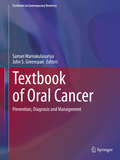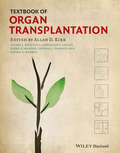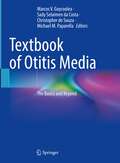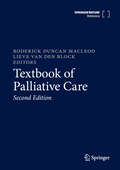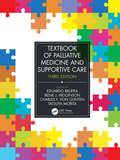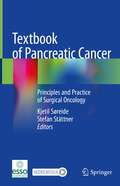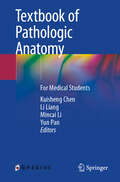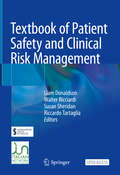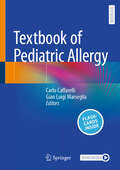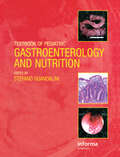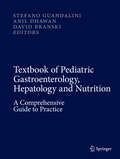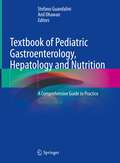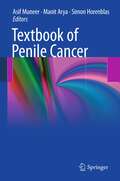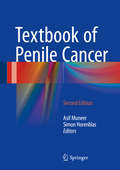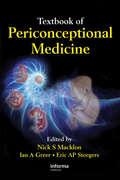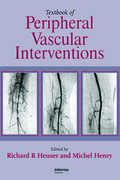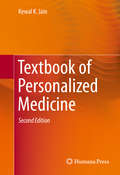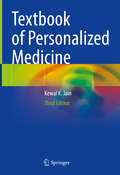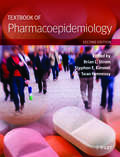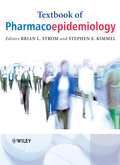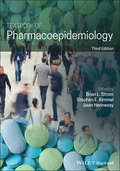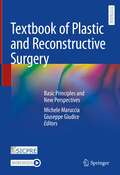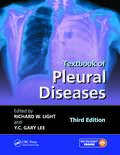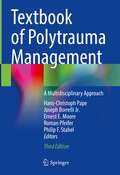- Table View
- List View
Textbook of Oral Cancer: Prevention, Diagnosis and Management (Textbooks in Contemporary Dentistry)
by Saman Warnakulasuriya John S. GreenspanThis comprehensive multidisciplinary book examines all aspects of cancers of the mouth and oropharynx with the aim of equipping advanced students and practitioners in the early stages of specialist training with an up-to-date guide and reference. A multinational team of authors – all experts in the field of oral oncology – provide illuminating contributions on the full range of relevant topics: epidemiology, risk factors, clinical features, staging and prognostic factors, pathology, diagnostic techniques, disease prevention, surgery, radiotherapy, and chemotherapy. Molecular biology, molecular targeted therapies for advanced cases, and future diagnostic and prognostic applications of new technologies also receive careful attention. In providing a wealth of essential information and guidance in a practical format, the book will be a superb asset for senior graduate students in dentistry and specialist trainees in head and neck oncology. It will also be of high value for the many physicians, surgeons, pathologists, dentists, and specialists involved in the prevention, diagnosis, and management of squamous cell carcinomas of the oral cavity and oropharynx.
Textbook of Organ Transplantation Set
by Joren C. Madsen Steven A. Webber Thomas C. Pearson Christian P. Larsen Allan D. Kirk Stuart J. KnechtleBrought to you by the world's leading transplant clinicians, Textbook of Organ Transplantation provides a complete and comprehensive overview of modern transplantation in all its complexity, from basic science to gold-standard surgical techniques to post-operative care, and from likely outcomes to considerations for transplant program administration, bioethics and health policy. Beautifully produced in full color throughout, and with over 600 high-quality illustrations, it successfully: Provides a solid overview of what transplant clinicians/surgeons do, and with topics presented in an order that a clinician will encounter them. Presents a holistic look at transplantation, foregrounding the interrelationships between transplant team members and non-surgical clinicians in the subspecialties relevant to pre- and post-operative patient care, such as gastroenterology, nephrology, and cardiology. Offers a focused look at pediatric transplantation, and identifies the ways in which it significantly differs from transplantation in adults. Includes coverage of essential non-clinical topics such as transplant program management and administration; research design and data collection; transplant policy and bioethical issues. Textbook of Organ Transplantation is the market-leading and definitive transplantation reference work, and essential reading for all transplant surgeons, transplant clinicians, program administrators, basic and clinical investigators and any other members of the transplantation team responsible for the clinical management or scientific study of transplant patients.
Textbook of Otitis Media: The Basics and Beyond
by Chris De Souza Marcos V. Goycoolea Sady Selaimen da Costa Michael M. PaparellaThis textbook presents a broad approach to otitis media ranging from the basic to the advanced, and comprehensively reviews the diagnosis, treatment, management, and complications of patients with infections of the middle ear (OM). It has been proven that children whose hearing has been affected by otitis media suffer academically. Since their hearing is impaired, their scholastic performance deteriorates, leading to multiple health and social problems. This in turn has a cascading effect on the child's ability to perform and cope. Quite often these problems are silent and go unrecognized and misdiagnosed. The socioeconomic impact of otitis media is profound and can deeply and adversely impact a child's growth and development if not diagnosed correctly and in a timely manner.The textbook starts by covering the basics, including chapters on classification and terminology, anatomy and embryological development of the inner ear, the immune system and the inner ear, inflammation and infection, genetic predisposition, current treatment strategies including surgical and non-surgical approaches, and hearing devices. Following chapters review the current and future state of the art in OM, including chapters on tympanoplasty, temporal bone cholesteatomas, advanced hearing and balance evaluations, advanced imaging evaluations, and mastoidectomy. Textbook of Otitis Media will be a go-to resource for otorhinolaryngology residents and fellows, pediatricians, ENT surgeons, consultants, nurses, and audiologists.
Textbook of Palliative Care
by Roderick Duncan MacLeod Lieve Van den BlockThis second edition provides the most up-to-date information on all aspects of palliative care including recent developments (including COVID-19), global policies, service provision, symptom management, professional aspects, organization of services, palliative care for specific populations, palliative care emergencies, ethical issues in palliative care, research in palliative care, public health approaches and financial aspects of care. This new Textbook of Palliative Care remains a unique, comprehensive, clinically relevant and state-of-the art book, aimed at advancing palliative care as a science, a clinical practice and as an art. Palliative care has been part of healthcare for over fifty years but it still needs to explained to many. Healthcare education and training has been slow to recognize the vital importance of ensuring that all practitioners have a good understanding of what is involved in the care of people with serious or advanced illnesses and their families. However, the science of palliative care is advancing and this new edition will contribute to a better understanding. This new edition offers 86 updated or new chapters out of 108, written by experts in their given fields, providing up-to-date information on a wide range of topics of relevance to those providing care towards the end of life no matter what the disease may be. We present a global perspective on contemporary and classic issues in palliative care with authors from a wide range of disciplines involved in this essential aspect of care. The Textbook includes sections addressing aspects such as symptom management and care provision, organization of care in different settings, care in specific disease groups, palliative care emergencies, ethics, public health approaches and research in palliative care. This new Textbook will be of value to practitioners in all disciplines and professions where the care of people approaching death is important, specialists as well as non-specialists, in any setting where people with serious advanced illnesses are residing. It is also an important resource for researchers, policy-and decision-makers at national or regional levels. Neither the science nor the art of palliative care will stand still so the Editors and contributors from all over the world aim to keep this Textbook updated so that the reader can find new evidence and approaches to care.
Textbook of Palliative Medicine and Supportive Care
by Eduardo BrueraThis new edition provides the essential clinical guidance both for those embarking upon a career in palliative medicine and for those already established in the field. A team of international experts here distil what every practitioner needs to know into a practical and reliable resource.
Textbook of Pancreatic Cancer: Principles and Practice of Surgical Oncology
by Kjetil Søreide Stefan StättnerThis textbook provides a practically applicable resource for understanding the surgical oncology management of pancreatic cancer. It discusses relevant aspects of anatomy and pathophysiology along with the latest diagnostic techniques. Insightful descriptions are then provided detailing how to perform critical surgical procedures when treating these patients. Relevant perioperative management strategies and emerging themes in cancer biology critical to understanding and treating the disease are also described. The need for cross-discipline collaboration to facilitate and enhance innovation within the discipline is reinforced throughout the text. Each chapter presents the relevant current clinical standards along with areas of controversy in both research and clinical practice within “pearls and pitfalls” sections. Textbook of Pancreatic Cancer: Principles and Practice of Surgical Oncology is a detailed work covering the basic material important to trainees as well as advanced curriculum for established specialists in the field from a multi-disciplinary perspective. Therefore, it is crucial resource for all practicing and trainee professionals who encounter these patients in their day-to-day clinical practice.
Textbook of Pathologic Anatomy: For Medical Students
by Kuisheng Chen Li Liang Mincai Li Yun PanThis book introduces the basic knowledge about pathologic anatomy, which covers the the etiology, pathogenesis, pathological changes and outcomes of diseases. It will help the student to understand and master the nature of various diseases and the theories in occurrence and development.This book consists of 18 chapters, including 6 chapters in general pathology and 12 chapters in systematic anatomy. In each chapter, it starts from the most important ‘Key Concepts’ to learn, which will guide the student during the learning stage and review stage.This book is a useful textbook for graduate and undergraduate students in medical schools, including MBBS (Bachelor of Medicine and Bachelor of Surgery) student.
Textbook of Patient Safety and Clinical Risk Management
by Walter Ricciardi Riccardo Tartaglia Liam Donaldson Susan SheridanImplementing safety practices in healthcare saves lives and improves the quality of care: it is therefore vital to apply good clinical practices, such as the WHO surgical checklist, to adopt the most appropriate measures for the prevention of assistance-related risks, and to identify the potential ones using tools such as reporting & learning systems.The culture of safety in the care environment and of human factors influencing it should be developed from the beginning of medical studies and in the first years of professional practice, in order to have the maximum impact on clinicians' and nurses' behavior. Medical errors tend to vary with the level of proficiency and experience, and this must be taken into account in adverse events prevention. Human factors assume a decisive importance in resilient organizations, and an understanding of risk control and containment is fundamental for all medical and surgical specialties. This open access book offers recommendations and examples of how to improve patient safety by changing practices, introducing organizational and technological innovations, and creating effective, patient-centered, timely, efficient, and equitable care systems, in order to spread the quality and patient safety culture among the new generation of healthcare professionals, and is intended for residents and young professionals in different clinical specialties.
Textbook of Pediatric Allergy
by Carlo Caffarelli Gian Luigi MarsegliaThis textbook provides a comprehensive and state-of-the-art coverage of allergic diseases and related cell-based conditions in the pediatric patient. All most common disorders as allergies to drugs, food (including non IgE-mediated food allergy), asthma, allergens, pollutants, and much more are presented, as well as parts on wheezing, daily routine and quality of life in affected children.This very informative volume book contains all the latest options to manage patients effectively using detailed treatment protocols. Topics are presented in a systematic, clear and didactic style for easy learning: the memorizing of contents can be tested by the reader through the self-assessment cards included in the volume. Written by experts with decades of teaching experience in the field, Textbook of Pediatric Allergy constitutes a much needed, innovative resource combining updated, reliable and comprehensive information with agile consultation and self-evaluation. The contents will appeal to medical students, nurses and allergy practitioners seeking to understand mechanisms behind the clinical signs, as well as the latest information on treating children with allergy and asthma.Additional questions via app: Download the Springer Nature Flashcards app for free and use exclusive additional material to test your knowledge.
Textbook of Pediatric Gastroenterology and Nutrition
by Stefano GuandaliniTaking a global approach to the subject, this book offers, in a comprehensive, cohesive package, information that is reflective of the different realities of gastroenterological and nutritional problems in different parts of the world. Designed to provide clinical knowledge in a convenient format, the chapters highlight the most common clinical concerns seen on a daily basis by the practicing pediatric gastroenterologist. Covering issues relevant for the diagnosis and treatment of a full range of problematic conditions, including nutritional disorders, the book is an up-to-date, reliable clinical primer on the disorders and diseases that may affect the gastrointestinal tract in neonates and children.
Textbook of Pediatric Gastroenterology, Hepatology and Nutrition
by Stefano Guandalini Anil Dhawan David BranskiThis textbook provides a comprehensive and state-of-the-art overview of the major issues specific to the field of pediatric gastroenterology, hepatology, and nutrition. The first part of the book, Gastroenterology and Nutrition, presents in a systematic way the overall scope of issues encountered by children (newborn to teenagers) suffering from disorders of the gastrointestinal tract, pancreas and/or presenting nutritional issues. These chapters are structured in logical sections to facilitate consultation and include major topics ranging from congenital disorders to gastrointestinal problems of the newborn, infectious diseases of the gastrointestinal tract, and approach to nutritional problems in the various pediatric ages. The second part of the book, Hepatology, is articulated in a series of chapters which present a comprehensive review of congenital and acquired disorders of the biliary tract and liver. This section also includes a critical analysis of available diagnostic and therapeutic procedures and future perspectives. Written by experts in the field, Textbook of Pediatric Gastroenterology, Hepatology and Nutrition: A Comprehensive Guide to Practice constitutes a much needed, innovative resource combining updated, reliable and comprehensive information with agile consultation for a streamlined approach to the care of children with such disorders.
Textbook of Pediatric Gastroenterology, Hepatology and Nutrition: A Comprehensive Guide to Practice
by Stefano Guandalini Anil DhawanThe latest edition of this textbook provides a comprehensive, state-of-the-art overview of the major issues specific to the field of pediatric gastroenterology, hepatology, and nutrition. The textbook begins with a section on gastroenterology and nutrition that presents the overall scope of issues encountered in children suffering from disorders of the gastrointestinal tract, pancreas, and/or presenting nutritional issues, as well as current and future prospects on the use of prebiotics, probiotics, and postbiotics. The second section is centered around hepatology, reviewing congenital and acquired disorders of the biliary tract and liver, as well as analyzing available diagnostic and therapeutic procedures and future perspectives.Written by experts in the field, Textbook of Pediatric Gastroenterology, Hepatology and Nutrition: A Comprehensive Guide, Second Edition is an indispensable resource for students, trainees, and clinicians, sure to distinguish itself as the definitive reference on this topic.
Textbook of Penile Cancer
by Manit Arya Simon Horenblas Asif MuneerTextbook of Penile Cancer reports accurately on recent developments in the management of penile cancer, whilst also covering the fundamentals of the disease, to provide a comprehensive, stand-alone and up-to-date volume on the subject. The surgical management of penile cancer is shifting towards increasingly refined methods, as it is believed that a proportion of patients undergo overtreatment for the disease. Where traditionally the management of penile cancer has involved partial or total penectomy combined with radical inguinal lymphadenectomy, over the last few years the treatment involves conservative penile reconstructive surgery such that sexual function and phallic length is preserved. Furthermore, the increasing utilization of sentinel lymph node biopsy rather than radical inguinal lymphadenectomy prevents the unnecessary removal of lymph nodes in patients where lymph node metastases has not occurred. There is also likely to be a change in the role of chemotherapy and radiotherapy for advanced disease. Textbook of Penile Cancer covers the epidemiology, molecular biology, radiological imaging, as well as the latest surgical advances in the treatment of this disease. This book is a valuable reference tool for Urological Surgeons, Genitourinary Physicians, Trainee Surgeons, Plastic Surgeons, Oncologists, Dermatologists and Sexual Health Physicians.
Textbook of Penile Cancer
by Simon Horenblas Asif MuneerThe aim of the updated book is to include new developments and update the literature in relation to sentinel node biopsy, new radiology techniques and long term epidemiological data. This book is useful for urologists, dermatologists, sexual health physicians as well as those with an interest in virology and genomics related to squamous cell cancers. The surgical techniques are all well illustrated with a step by step guide in order to allow those individuals in centres which are not expert centres to undertake the management of this devastating tumour.
Textbook of Periconceptional Medicine
by Nick S Macklon Ian A Greer Eric Ap SteegersA new subspecialty is growing at the interface of reproductive medicine and perinatology: infertility. Textbook of Periconceptional Medicine provides an authoritative and comprehensive reference resource for those providing medical care to women trying to conceive a healthy pregnancy.A revolutionary first edition, this text brings together a number
Textbook of Peripheral Vascular Interventions
by Michel Henry Richard R HeuserTextbook of Peripheral Vascular Intervention, Second Edition, discusses therapies that can make a real difference in the lives of patients. As there are increasing demands for effective, less invasive approaches to therapies for critical limb ischemia, chronic total occlusions, as well as therapies for some subsets.
Textbook of Personalized Medicine
by Kewal K. JainPersonalized medicine, which simply means selection of treatment best suited for an individual, involves integration and translation of several new technologies in clinical care of patients. The scope is much broader than indicated by the term genomic medicine because many non-genomic factors are taken into consideration in developing personalized medicine. Basic technologies for personalized medicine, of which molecular diagnostics has the biggest share, are mentioned briefly and appropriate references are given for further information. Commercial aspects are discussed briefly in a chapter and detailed analysis of markets and companies involved in personalized medicine is presented in a special report on this topic. There is increasing interest in personalized medicine. Considerable advances have taken place in molecular biology and biotechnology to make personalized medicine a viable option, but some misconceptions still exist, both in the academic and commercial sectors. There is lack of a suitable source of information that provides both the fundamentals as well as applications of personalized medicine. As the latest version of the first monograph on personalized medicine published in 1998, this volume, Textbook of Personalized Medicine, summarizes the author's efforts during the past decade, as well as reviews selected studies done during this period in a readable format for the physicians and scientists. It is hoped that physicians, pharmacists, scientists and interested lay readers with basic scientific knowledge will find this book useful.
Textbook of Personalized Medicine
by Kewal K. JainThis book is for personalized medicine as a prescription of specific treatments and therapeutics best suited for an individual and considers genetic as well as environmental factors that influence responses to therapy. Best approaches are described for integration of all available technologies for optimizing the therapy of individual patients. This comprehensive third edition covers the latest advances in personalized medicine and several chapters are devoted to various specialties, particulary cancer which is the largest area of application. The book discusses the development of personalized medicine and various players in it such as companies, academic institutions, the government, and the public as the consumer of healthcare. Additionally, the roles of bioinformatics, electronic health records, and digital technologies for personalized medicine are discussed. Textbook of Personalized Medicine, 3rd Edition serves as a convenient source of information for students at many levels and in a wide range of fields, including physicians, scientists, and decision makers in the biopharmaceutical and healthcare industries.
Textbook of Pharmacoepidemiology
by Brian L. Strom Sean Hennessy Stephen E. KimmelTextbook of Pharmacoepidemiology, Second Edition, provides an introduction to pharmacoepidemiology and the methodologies, data sources and applications used in clinical practice, the pharmaceutical industry and regulatory agencies. This second edition includes new and updated learning features, case examples and key points, as well as information on the new pharmacoepidemiology databases and how to use them.
Textbook of Pharmacoepidemiology
by Brian L. Strom Stephen E KimmelThe Textbook of Pharmacoepidemiology provides a streamlined text for evaluating the safety and effectiveness of medicines. It includes a brief introduction to pharmacoepidemiology as well as sections on data sources, methodology and applications. Each chapter includes key points, case studies and essential references. One-step resource to gain understanding of the subject of pharmacoepidemiology at an affordable priceGives a perspective on the subject from academia, pharmaceutical industry and regulatory agenciesDesigned for students with basic knowledge of epidemiology and public healthIncludes many case studies to illustrate pharmacoepidemiology in real clinical setting
Textbook of Pharmacoepidemiology
by Brian L. Strom Stephen E. Kimmel PharmD Sean HennessyPharmacoepidemiology originally arose from the union of the fields of clinical pharmacology and epidemiology. Pharmacoepidemiology studies the use of and the effects of medical products in large numbers of people and applies the methods of epidemiology to the content area of clinical pharmacology. This field represents the science underlying studies of the effects of medical products (such as drugs, biologicals, and devices) in real world use. Strom’s Textbook of Pharmacoepidemiology meets the increasing need for people to be trained in the field. Designed to meet the need of students, this textbook offers an approach that focuses on the core of the discipline, providing a focused educational resource for students. The book is designed for students at all levels: upper-level undergraduates, graduate students, post-doctoral fellows, and others who are learning the field. Case examples feature in most chapters, and all chapters include key points and a list of further reading. Fully revised and updated throughout, Textbook of Pharmacoepidemiology, 3rd edition is a useful introduction and resource for students of pharmacoepidemiology, both those enrolled in formal classes and those learning in “the real world,” who will respond to the challenges that they encounter.
Textbook of Plastic and Reconstructive Surgery: Basic Principles and New Perspectives
by Michele Maruccia Giuseppe GiudiceFilling a gap in the present inventory of Plastic Surgery Textbooks, this compact, practice-oriented study guide delivers comprehensive, clear and up-to-date information on all the basics of plastic surgery in clinical practice. Methodological rigor, together with a lean style and layout were chosen; boxes and teaching objectives are included to help memorize fundamentals. Starting from basics such as the physiology and pathology of skin and wound healing, suture techniques, dressings and dermal substitutes, grafts, flaps and microsurgical techniques, the textbook then tackles topics including malformations, skin cancer, and traumas like burns and wounds. The respective contributions were written by American, British, Italian, German, Korean and Taiwanese teaching experts in the field. Over 250 full color illustrations, line drawings, and videos support the main text: accordingly, this textbook will appeal to advanced, upper-undergraduate students and residents preparing for plastic and reconstructive surgery in-training.
Textbook of Pleural Diseases
by Richard W. Light Y.C. Gary LeeThe Second Edition of this book was the Winner of the First Prize (Respiratory Category) at the British Medical Association Medical Book Awards. Textbook of Pleural Diseases is a comprehensive reference that covers both the basic and clinical science on pleural diseases. Building on the highly respected previous editions, it includes a detailed bas
Textbook of Polytrauma Management: A Multidisciplinary Approach
by Hans-Christoph Pape Philip F. Stahel Ernest E. Moore Joseph Borrelli Jr. Roman PfeiferThis textbook is a fully updated and revised third edition of a highly successful practical guide to the care of the polytrauma patient. Broadening its readership to students, this new edition comprehensively describes the clinical course of multiple and severe injuries, from the accident scene to rehabilitation.It provides essential practical information on the care of patients both with blunt and penetrating trauma to multiple body regions, and discusses the management of truncal injuries (head, chest, abdomen) as well as fractures of the extremities, pelvis and spine. Further, the book highlights associated injuries that may alter decisions concerning patients with polytrauma. This new, revised edition takes full account of recent developments, including the increasing economic pressure on health care systems, prehospital treatment, changes in trauma systems and related education, and the improved survival of polytrauma patients. Also covering improved monitoring options along with issues in late patient outcomes and rehabilitation this work will greatly assist students, emergency personnel, trauma surgeons, orthopaedic traumatologists, and anesthesiologists.
Textbook of Primary Care Dermatology
by Paola Pasquali David BuckleyThis textbook provides a comprehensive, practical guide to the identification of a range of common dermatological conditions encountered within primary care. It features a problem-based approach to the topics and conditions covered. Clinical photographs, diagrams and pertinent tables along with clear learning objectives, clinical pearls and pitfalls in each chapter facilitate understanding in the diagnosis and management of a range of common dermatological conditions. Textbook of Primary Care Dermatology empowers the reader to develop their understanding of how to deal with a range of common skin, hair and nail problems. It is ideal for training and practising primary care physicians seeking a quick reference guide to use in their clinical practice and the trainee dermatologist seeking a primer on the topic. It is also suitable for other members of the primary care team including nurses, pharmacists, physician associates and clinical assistants, and it is very useful for hospital-based doctors and nurses in other disciplines who want a quick, practical reference to common dermatological problems.
